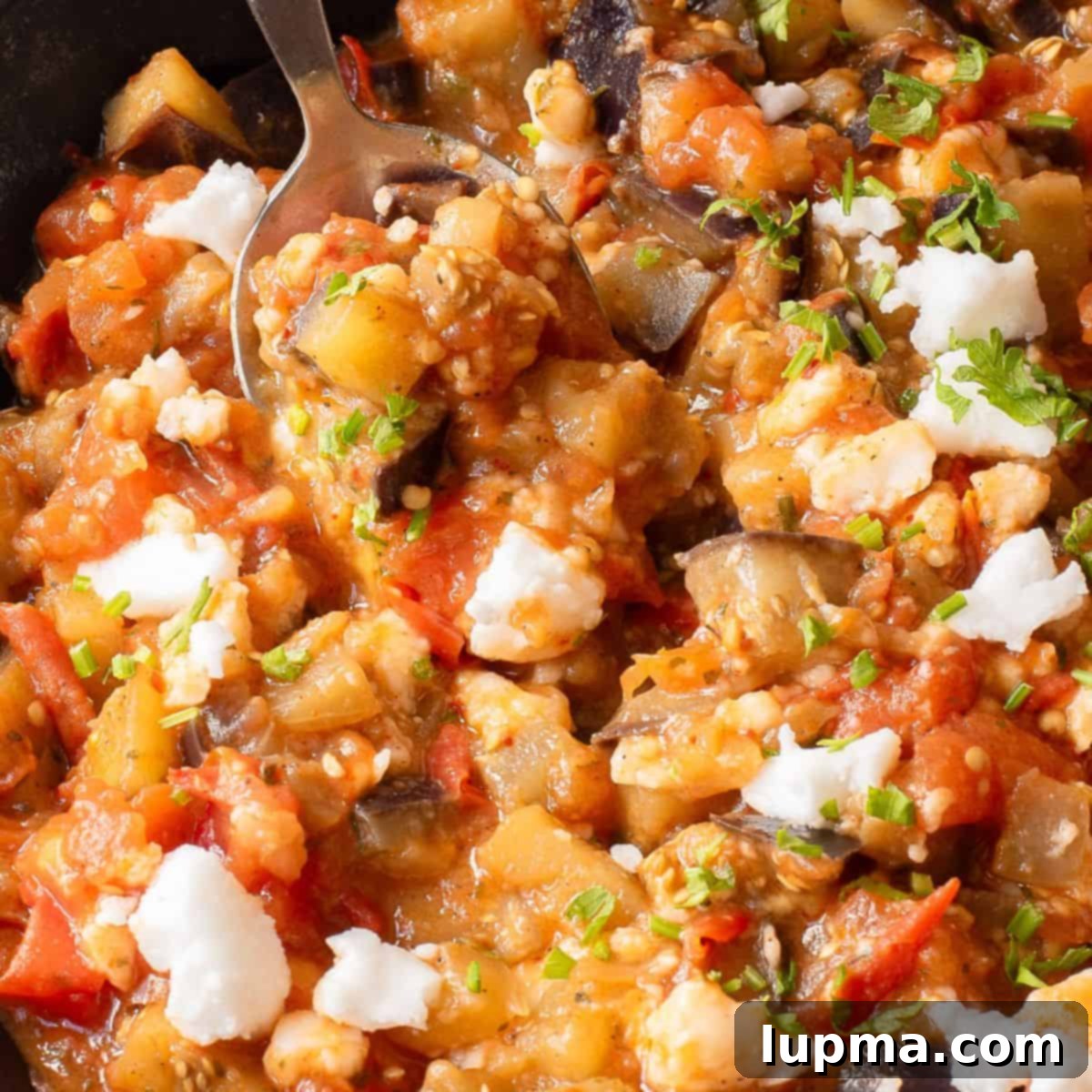Easy Skillet Tomato and Eggplant with Feta: A Flavorful Mediterranean Delight
Discover the delightful simplicity of my Skillet Tomato and Eggplant with Feta, a vibrant dish that perfectly marries soft, tender eggplant with juicy, ripe tomatoes. Infused with aromatic spices and finished with creamy, tangy feta cheese, this Mediterranean-inspired creation is an absolute must-try. Whether you’re seeking a quick and healthy side dish or a satisfying light main course, this recipe delivers a burst of fresh flavors and comforting textures that will transport your taste buds straight to the sun-drenched shores of the Mediterranean.

This recipe exemplifies how truly remarkable dishes can be crafted from a handful of humble ingredients. With just a few fresh vegetables, a selection of pantry-staple spices, and a sprinkle of aromatic herbs, you can create a meal that’s both deeply satisfying and incredibly healthy. The inclusion of tangy feta cheese is my secret weapon, adding an irresistible salty creaminess that complements the caramelized vegetables beautifully. It transforms a simple vegetable sauté into an elevated culinary experience, making it a perfect addition to any meal.
While this Skillet Tomato and Eggplant recipe shines as a versatile side dish, offering a fresh, vibrant accompaniment to almost any main course, its charm doesn’t stop there. It’s equally fantastic as a light lunch the following day. Simply warm up any leftovers and serve them atop a slice of crispy toasted crusty bread, fluffy couscous, or your favorite pasta. A final scattering of fresh herbs before serving will revive its freshness and add a delightful finish, making it perfect for meal prep or a quick, nutritious midday meal. This dish is not just food; it’s an experience waiting to happen, promising ease, flavor, and versatility in every bite.
If you’re an eggplant enthusiast, you’ll be thrilled to explore other ways to enjoy this incredible vegetable. Beyond this skillet recipe, consider learning how to make Air Fryer Eggplant for a quick and crispy alternative. For refreshing salad options, delve into my Eggplant Salad or the hearty Mediterranean Eggplant Chickpea Salad. And for a fun, appetizer-friendly twist, these Eggplant Fries are sure to be a crowd-pleaser. Each recipe offers a unique way to savor the rich, earthy flavors of eggplant, ensuring there’s something for every occasion.
Why You’ll Absolutely Love This Skillet Tomato and Eggplant Recipe
This Skillet Tomato and Eggplant dish isn’t just another recipe; it’s a testament to simple, delicious cooking that fits effortlessly into any lifestyle. Here are even more compelling reasons why it deserves a permanent spot in your culinary repertoire:
- Effortless and Quick Preparation: In today’s busy world, finding recipes that are both delicious and don’t demand hours in the kitchen is a true gem. This easy vegetable side dish is precisely that. Requiring only about 5 minutes of active preparation time and a mere 15 minutes to cook, it’s the quintessential mid-week dinner solution. You can have a wholesome, homemade meal on the table in under half an hour, making it perfect for those hectic evenings when time is of the essence.
- Incredibly Versatile and Adaptable: One of the greatest strengths of this Skillet Tomato and Eggplant recipe is its remarkable versatility. It serves as an excellent foundation that can be easily customized to suit your family’s preferences or whatever fresh produce you have on hand. Feel free to experiment with additional vegetables like bell peppers, zucchini, or spinach, adjust the spice levels, or incorporate different fresh herbs. This adaptability means you can enjoy a slightly different version every time you make it, preventing mealtime monotony and ensuring it always feels fresh and exciting.
- Deliciously Vegetarian-Friendly: For those following a vegetarian diet or looking to incorporate more meat-free meals into their weekly menu, this dish is a fantastic option. Most feta cheese is vegetarian-friendly, making this a hearty and flavorful plant-based meal. It’s packed with nutrient-rich vegetables and satisfying textures, proving that vegetarian dishes can be incredibly delicious and fulfilling without compromising on taste or substance.
- Healthy and Nutritious: Beyond its incredible taste, this skillet dish is brimming with healthy goodness. Eggplant is rich in fiber and antioxidants, while tomatoes provide a significant dose of vitamins C and K, and potassium. Olive oil adds healthy monounsaturated fats, and fresh herbs contribute additional vitamins and minerals. It’s a meal that not only tastes good but also nourishes your body, making it a guilt-free indulgence.
- Budget-Friendly Ingredients: You don’t need exotic or expensive ingredients to create a memorable meal. This recipe relies on readily available and affordable produce like eggplant and tomatoes, along with common spices. This makes it an excellent choice for budget-conscious cooks who still want to enjoy high-quality, flavorful food without breaking the bank.
- Mediterranean-Inspired Flavors: The combination of ripe tomatoes, tender eggplant, aromatic oregano, and salty feta cheese evokes the wonderful flavors of Mediterranean cuisine. This culinary style is renowned for its emphasis on fresh, wholesome ingredients and vibrant tastes, and this dish is a perfect example of that. It’s a mini-vacation for your palate, offering a taste of sunshine and tradition.
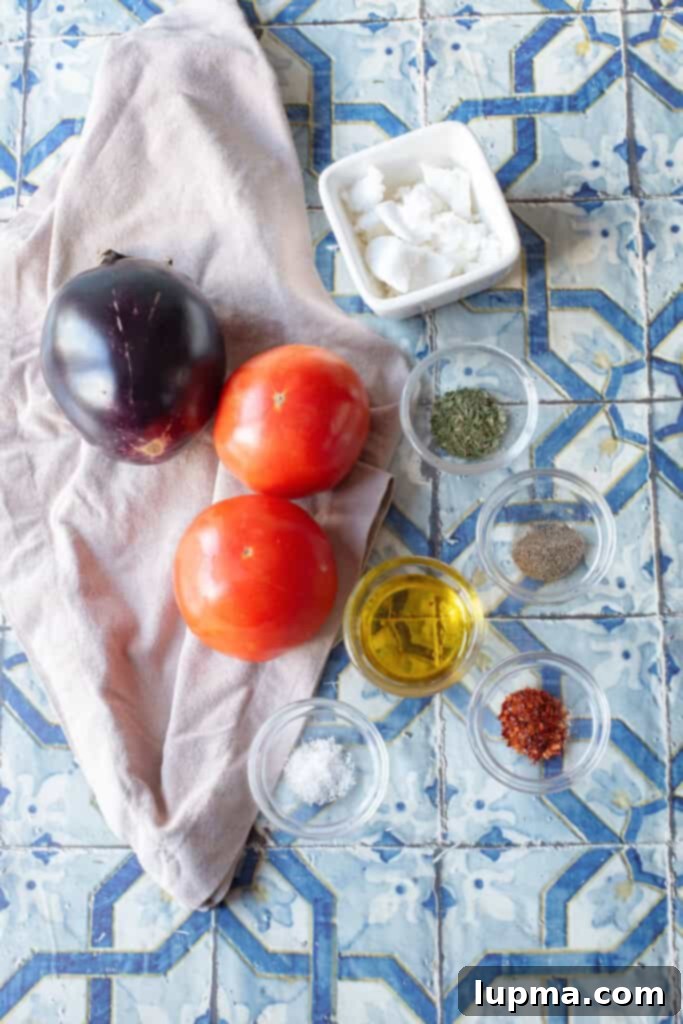
Essential Ingredients You’ll Need for This Skillet Tomato & Eggplant
Crafting this flavorful Skillet Tomato and Eggplant dish requires a few simple, fresh ingredients that come together to create a harmonious blend of tastes and textures. Below is a detailed overview of what you’ll need. For precise measurements and step-by-step printable instructions, please refer to the comprehensive recipe card located further down this page.
- Eggplant: For this recipe, I recommend using one medium-sized eggplant. This quantity is ideal for serving four people as a satisfying side dish or two people if enjoyed as a lighter main course. When selecting eggplant, look for firm, glossy skin without blemishes, and choose one that feels heavy for its size. Fresh eggplant is key for the best texture and flavor in your skillet dish. If you opt for smaller Japanese eggplants, you might need two or three to achieve the same volume.
- Tomatoes: I typically use two medium-sized fresh tomatoes. Vine-ripened tomatoes are highly recommended as they boast a superior, more intense flavor that truly enhances the dish. If smaller cherry or grape tomatoes are more readily available or preferred, then you’ll need approximately 10-12 of them, halved, to achieve the desired tomato richness. The sweetness and acidity of fresh tomatoes are crucial to balancing the earthy eggplant.
- Spices: The foundation of this dish’s exquisite flavor comes from a carefully selected blend of spices. I use **dried oregano** for its classic Mediterranean aroma, **paprika** to add a mild, sweet warmth and beautiful color, **sea salt** to enhance all the flavors, and freshly ground **black pepper** for a subtle kick. For those who appreciate a touch of heat, a sprinkle of **red pepper flakes** is an optional but highly recommended addition that provides a lovely chili warmth. Ensure your spices are fresh for maximum impact.
- Cheese: The star of the creamy, tangy finish is **crumbled feta cheese**. Adding feta to the hot skillet allows it to gently melt and meld with the cooked tomatoes and eggplant, creating a rich, savory depth. Its salty, briny flavor provides a perfect contrast to the sweet vegetables, making every bite incredibly satisfying. Look for good quality block feta for the best flavor, crumbling it yourself.
- Fresh Herbs: To elevate the dish with a burst of freshness and vibrant color, I always finish it with a generous scattering of freshly chopped herbs. **Fresh parsley** or **basil** are my go-to choices, as their bright, herbaceous notes provide a beautiful counterpoint to the cooked vegetables and creamy feta. Don’t skip this step, as fresh herbs truly make a difference in the overall aroma and taste profile and add an appealing garnish.
- Olive Oil: A good quality **extra virgin olive oil** is essential for sautéing the vegetables and building the flavor base of this Mediterranean-inspired dish. It adds a fruity, peppery note and helps achieve that desirable caramelization on the eggplant. Choose a robust olive oil for a richer taste.
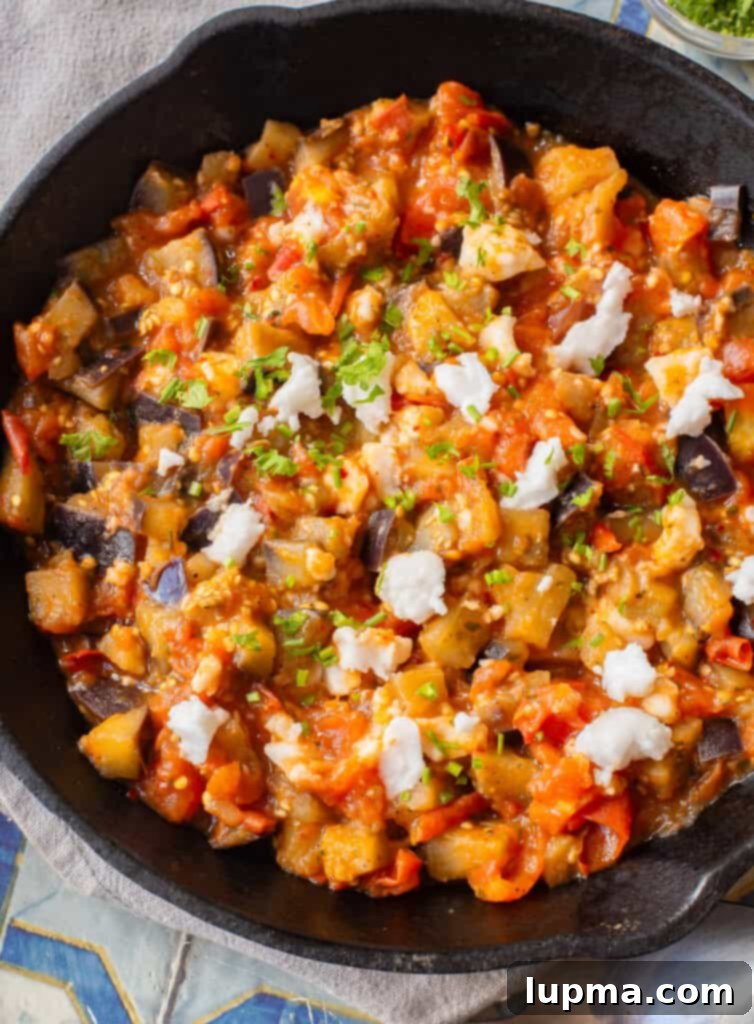
Exciting Recipe Variations to Customize Your Skillet Tomato & Eggplant
One of the true beauties of this Skillet Tomato and Eggplant recipe lies in its incredible adaptability. It’s a fantastic canvas for culinary creativity, allowing you to easily adjust ingredients based on what you have on hand, seasonal availability, or simply your personal taste preferences. Don’t hesitate to experiment with these exciting variations to make the dish uniquely yours and explore new flavor combinations:
- Add More Vegetables: While fresh tomato and eggplant form the core of this dish, it welcomes a variety of other vegetables. Consider adding thinly sliced **red onion** for a pungent sweetness and a lovely texture, fresh **spinach** or kale that wilts beautifully into the warm mixture and boosts nutrient content, colorful **bell peppers** (red, yellow, or orange) for crunch, sweetness, and vibrant hues, sliced **mushrooms** for an umami boost and meaty texture, crisp **celery** for subtle flavor and texture, or tender **zucchini** for added bulk and a milder taste. Simply add them to the skillet alongside the eggplant or tomatoes, adjusting cooking times as needed to ensure they are tender-crisp and not overcooked.
- Transform it with Tomato Sauce: For a heartier, saucier version, this recipe serves as a brilliant base for incorporating your favorite prepared **tomato sauce**. Once the vegetables are tender, stir in a cup or two of marinara, arrabbiata, or a simple crushed tomato sauce. This instantly transforms the dish into a more substantial meal, perfect for serving over pasta, polenta, rice, or as a rich stew. The added sauce will absorb all the wonderful flavors from the sautéed vegetables, creating a more robust dish.
- Boost Flavor with Garlic: For garlic lovers, a few cloves of minced **fresh garlic** can profoundly enhance the overall aroma and taste profile. Add the minced garlic to the skillet a minute or two before adding the tomatoes, allowing it to become fragrant but taking care not to burn it, as burnt garlic can become bitter. Its pungent, sweet flavor will beautifully complement the earthy eggplant and sweet tomatoes.
- Embrace Briny Olives: A handful of your favorite pitted **olives** – whether they’re salty Kalamata, mild green Castelvetrano, or a mix of both – can add a wonderful briny, salty depth to the dish. Stir them into the tomatoes and eggplant during the last few minutes of cooking, just enough to warm them through. Their distinct flavor profiles will add another layer of Mediterranean charm and complexity.
- Explore Different Spices: I’ve kept the seasoning simple to highlight the fresh produce, but the recipe is incredibly forgiving when it comes to spices. Experiment with a dash of **Italian seasoning** for a classic blend of herbs like basil, oregano, and thyme; a pinch of **garlic powder** or onion powder for a milder, aromatic base; or a sprinkle of **cayenne pepper** or chili powder if you desire a more pronounced spicy kick. Smoked paprika can also add a delightful smoky undertone, while a touch of cumin can introduce an earthy, Middle Eastern twist.
- Vary Your Fresh Herbs: While parsley and basil are excellent choices for their bright, fresh notes, feel free to finish the dish with other fresh herbs. **Rosemary** offers a woody, fragrant note, especially nice with a touch of lemon; **thyme** provides an earthy, savory flavor that pairs well with eggplant; and **fresh mint** can add a surprising, cooling, and refreshing twist, particularly if serving the dish chilled or at room temperature.
- Alternative Cheeses: While crumbled feta cheese is my preferred choice for its unique tang and creamy texture that melts beautifully, you can certainly swap it for other cheeses. Try shredded **mozzarella** for a milder, meltier, and stretchier texture; grated **Parmesan** or Pecorino Romano for a salty, umami kick; or a crumbly **goat cheese** for a distinct, earthy, and slightly tart flavor that pairs wonderfully with roasted or sautéed vegetables.
- Add a Protein Boost: To make this a more complete and substantial meal, consider stirring in cooked chickpeas or cannellini beans for a plant-based protein boost, offering extra fiber and richness. Alternatively, add shredded rotisserie chicken, crumbled cooked Italian sausage, or sautéed shrimp during the final stages of cooking to transform it into a robust main course for meat-eaters.
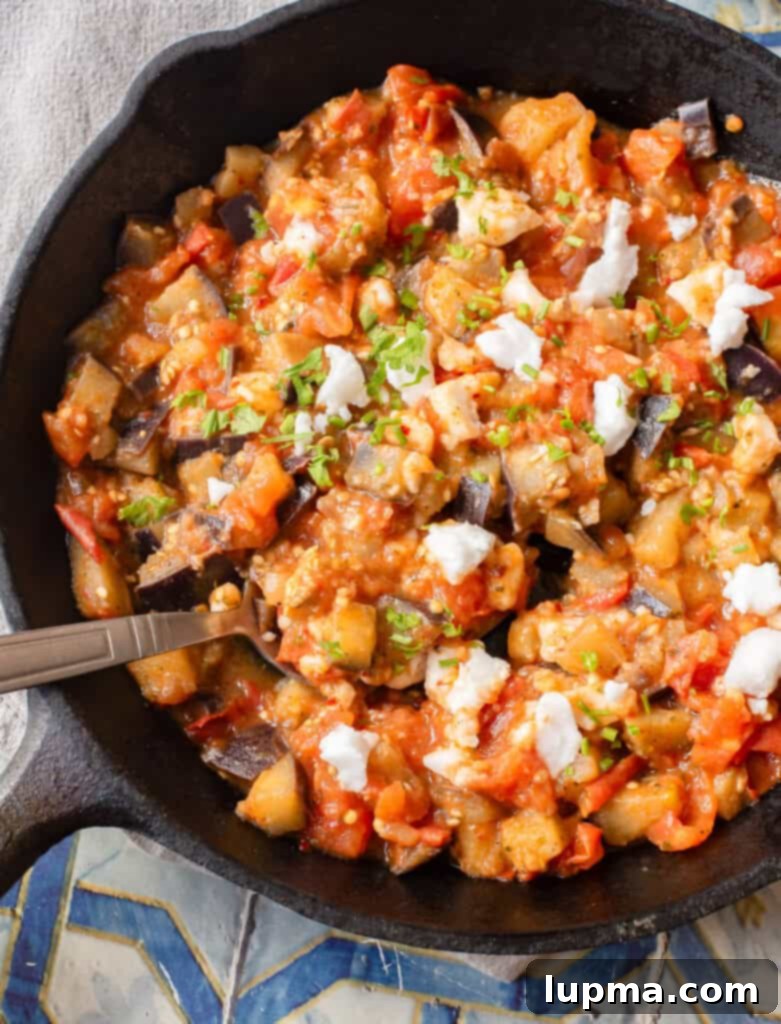
How to Master Skillet Tomato & Eggplant: A Simple Step-by-Step Guide
Creating this delicious Skillet Tomato and Eggplant dish is straightforward and requires minimal effort, making it ideal for both novice and experienced cooks. Follow these simple steps to achieve perfectly tender vegetables bursting with Mediterranean flavors.
Step 1. Prepare and Cook the Eggplant: Begin by adding 3 tablespoons of good quality olive oil to a medium-sized skillet. Heat the skillet over medium heat until the oil is shimmering gently. Carefully add your uniformly cubed eggplant pieces. To help the eggplant cook evenly and prevent it from drying out, add 2 tablespoons of water to the skillet. This creates a steamy environment that gently softens the eggplant from within while allowing it to develop a lovely golden-brown exterior. Cook the eggplant for approximately 5-7 minutes, stirring occasionally with a wooden spoon or spatula to ensure all sides get a chance to brown slightly and become tender. If you notice the skillet becoming too dry or the eggplant starting to stick, don’t hesitate to add an extra tablespoon of water or a small drizzle of olive oil to maintain moisture and prevent burning.
Step 2. Incorporate Tomatoes and Seasoning: Once the eggplant has softened significantly and taken on a slight golden hue, it’s time to introduce the vibrant flavors of the tomatoes and spices. Add the cubed fresh tomatoes to the skillet. Immediately follow with the dried oregano, paprika, sea salt, freshly ground black pepper, and if you’re using them, the red pepper flakes for a subtle touch of chili heat. Continue to stir the mixture gently but thoroughly, ensuring the spices are evenly distributed and coating all the vegetables. Cook for another 5 minutes, allowing the tomatoes to soften further and release their flavorful juices. These juices will meld beautifully with the tender eggplant, creating a rich, savory base for the dish. The goal here is a tender, cohesive vegetable mixture where all the flavors have had a chance to marry and deepen.
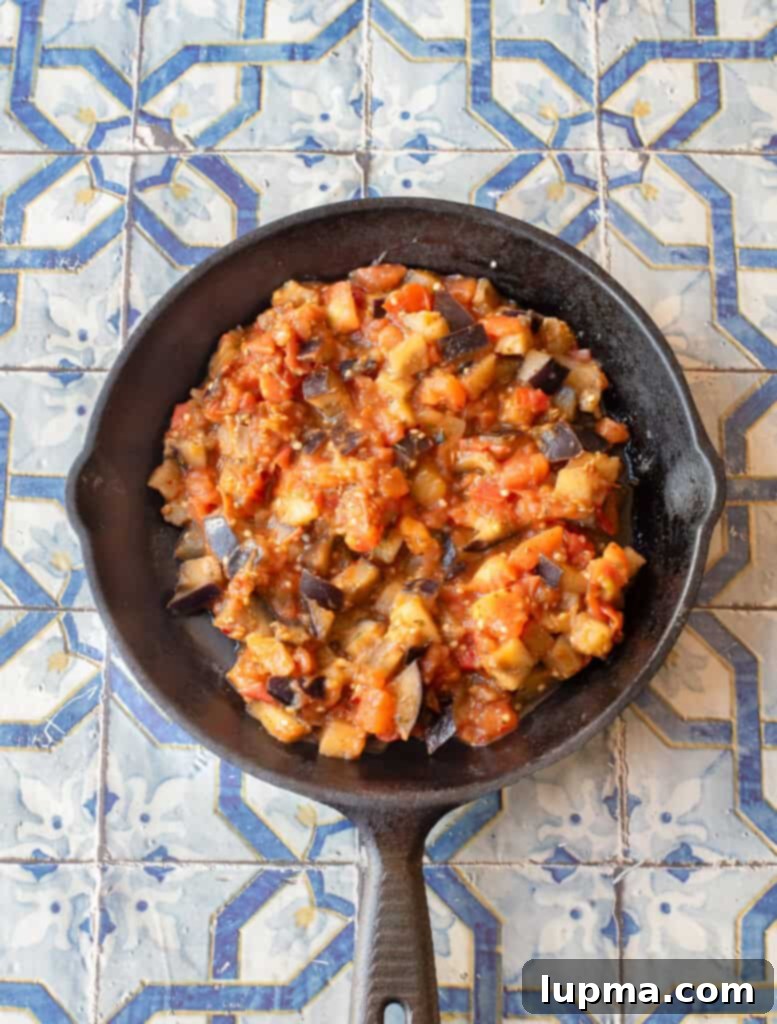
Step 3. Melt in the Feta Cheese: With your vegetables perfectly tender and seasoned, it’s time for the crowning glory: the feta cheese. Generously sprinkle the crumbled feta cheese evenly over the warm tomato and eggplant mixture in the skillet. Gently stir it in just enough for the cheese to soften and slightly melt, creating alluring pockets of creamy, salty goodness throughout the dish. Avoid over-stirring, as you want some distinct pieces of feta rather than it completely disappearing. The residual heat from the vegetables will perfectly warm the cheese, infusing the entire dish with its distinctive tangy flavor and adding a luxurious texture.
Step 4. Garnish and Serve Immediately: Once the feta has melted to your liking and the dish is bubbling gently, remove the skillet from the heat. Garnish the vibrant dish with a generous sprinkle of freshly chopped basil or parsley. The fresh herbs not only add a beautiful pop of contrasting color but also contribute a bright, aromatic finish that elevates the entire experience, bringing a garden-fresh touch. Serve your Skillet Tomato and Eggplant warm, either as a delightful and healthy side dish alongside your favorite protein or as a light yet satisfying main meal. It pairs exceptionally well with toasted crusty bread for dipping, fluffy rice, or light and airy couscous. Enjoy this delicious taste of the Mediterranean!
Expert Tip: Preparing Eggplant for Optimal Flavor and Texture
Salting eggplant before cooking is a classic chef’s trick that truly makes a significant difference in the final outcome of your dish. This simple step helps to draw out excess moisture from the eggplant, which is crucial for preventing it from becoming soggy and watery during cooking. Additionally, salting can reduce any potential bitterness that some eggplants might carry, resulting in a silkier, more tender, and more flavorful final product. To do this effectively, first slice or cube your eggplant as desired for the recipe. Then, lightly sprinkle the eggplant pieces with kosher or sea salt (be mindful not to use too much, just a light dusting). Place the salted eggplant in a colander or spread it out on several layers of paper towels for about 20–30 minutes. You’ll soon notice beads of moisture forming on the surface – this is the excess water being pulled out. Before cooking, it is absolutely essential to rinse the eggplant thoroughly under cold water to remove any residual salt, and then pat it completely dry with clean paper towels. This crucial step ensures your eggplant cooks beautifully, absorbing all the wonderful flavors of your skillet dish without diluting them, and achieves that desirable tender-but-not-mushy texture.
Creative Serving Suggestions for Your Skillet Tomato & Eggplant
This easy and delicious Skillet Tomato and Eggplant recipe is incredibly versatile and can be served in a multitude of ways, adapting beautifully to various meals and preferences. Whether you’re looking for a complementary side dish or a light, flavorful main course, here are some ideas to inspire your serving and elevate your dining experience:
- Perfect as a Vegetable Side: It excels as a vibrant, Mediterranean-inspired vegetable side dish. Its rich flavors and tender texture make it an ideal accompaniment to a wide range of proteins and main courses.
- With Grilled Meats: The fresh, tangy flavors cut through the richness of grilled meats. Try it with my Grilled Flank Steak with Dry Rub for a hearty and balanced meal, or complement the robust flavors of Mediterranean Beef Kabobs. The contrasting textures and flavors create a dynamic plate.
- Alongside Poultry: It’s a wonderful match for various chicken and turkey dishes. Serve alongside Mediterranean Baked Turkey Meatballs, flavorful Moroccan Chicken Thighs, or these succulent Grilled Chicken Thighs with Greek Marinade. The lightness of the vegetables beautifully balances the protein.
- Complementing Seafood: The light yet savory profile of the eggplant and tomato also creates a fantastic pairing with various seafood dishes, enhancing their delicate flavors.
- With Fish: The Mediterranean flavors are a natural complement to fresh fish. Try it with 15 Minute Grilled Salmon for a quick and healthy dinner, flaky Air Fryer Cod, delicate Black Sea Bass, or this classic Baked Cod with Lemon Sauce. The flavors are balanced, refreshing, and incredibly satisfying.
- As a Light Main Course: This dish is hearty enough to stand alone as a satisfying vegetarian main meal, especially when enhanced with a few simple additions or served creatively.
- With Bread: For a simple yet fulfilling meal, serve the warm eggplant and tomato mixture generously over slices of warm, crusty toasted bread. A good ciabatta or sourdough is perfect for soaking up all the delicious, flavorful juices.
- Over Grains: Spoon it over a bed of fluffy couscous, nutty quinoa, wholesome brown rice, or even your favorite pasta (like orecchiette or penne). This makes for a complete and wholesome vegetarian lunch or dinner, soaking up all the rich flavors.
- With Eggs: For a delightful breakfast, brunch, or even a light dinner, serve it alongside a perfectly fried, poached, or scrambled egg. The runny yolk of a fried or poached egg will add another layer of creamy richness to the vegetables.
- Stuffed Peppers or Zucchini: Use the skillet mixture as a delicious filling for halved bell peppers or hollowed-out zucchini boats, then bake until tender and bubbly for an impressive and wholesome meal.
- Cold as a Mezze Dish: Don’t forget that this dish can also be enjoyed chilled or at room temperature, making it a wonderful addition to a vibrant Mediterranean mezze platter alongside creamy hummus, marinated olives, crisp cucumber slices, and warm pita bread. Its flavors deepen as it cools, offering a refreshing and light option perfect for entertaining or a warm day.

Storage and Reheating Tips for Skillet Tomato & Eggplant
One of the many advantages of this Skillet Tomato and Eggplant dish is how well it stores, making it an excellent candidate for meal prepping or enjoying delicious leftovers. Proper storage ensures you can savor its wonderful flavors for days to come. Here’s how to handle your leftovers and keep them tasting fresh:
- Refrigeration: To store any leftover Skillet Tomato and Eggplant, it’s crucial to allow the dish to cool completely to room temperature first. This prevents condensation from building up inside the container, which can lead to sogginess and a less appealing texture. Once thoroughly cooled, transfer the eggplant and tomato mixture into an airtight container. It will keep beautifully and safely in the refrigerator for approximately 2-3 days. When you’re ready to enjoy it again, simply place the desired portion back into a hot skillet over medium heat, stirring occasionally until warmed through evenly. While microwaving is an option for convenience, reheating in a skillet helps maintain its texture better, preventing it from becoming too soft.
- Freezing: For longer storage, this versatile dish can also be frozen. After cooking, ensure the tomato and eggplant mixture is entirely cooled to room temperature. Then, transfer it into a freezer-safe ziplock bag, pressing out as much air as possible before sealing to prevent freezer burn, or use an airtight freezer-safe container. Label and date the container for easy tracking. The dish can be frozen for up to 3 months. When you’re ready to enjoy it, thaw the frozen dish in the refrigerator overnight. Once thawed, reheat it gently in a hot skillet over medium heat until thoroughly warm, or in the microwave if you’re in a hurry. Be aware that freezing might slightly alter the texture of the tomatoes and eggplant, making them a bit softer upon reheating, but the delicious flavor will still be fantastic.
- Reheating for Best Texture: When reheating, whether from the fridge or after thawing from frozen, using a skillet is generally preferred over a microwave. A hot skillet helps to gently re-caramelize the edges of the eggplant and tomatoes, bringing back some of that initial delicious texture and preventing a watery consistency. If the mixture seems a little dry during reheating, you can add a tablespoon of water, a splash of vegetable broth, or a small drizzle of fresh olive oil to rehydrate and refresh the flavors. Avoid over-reheating, which can lead to mushy vegetables.
Frequently Asked Questions About Skillet Tomato & Eggplant
Absolutely not! In most recipes, including this skillet dish, peeling eggplant is entirely unnecessary. The skin of a medium-sized eggplant softens wonderfully during cooking and is completely edible, adding valuable fiber, nutrients, and a touch of appealing texture to your meal. Plus, keeping the skin on helps the eggplant pieces maintain their shape and integrity in the skillet, preventing them from becoming mushy. So, save yourself the time and effort – you can confidently leave the skin on for this recipe.
Eggplant is a member of the nightshade family, and like other produce such as apples or avocados, its flesh contains phenolic compounds (specifically chlorogenic acid) that react with oxygen once exposed to the air. This chemical reaction, known as enzymatic oxidation, causes the cut surfaces to turn brown relatively quickly. While this browning doesn’t affect the taste or safety of the eggplant, it can be less visually appealing. For this reason, it’s always best practice to prepare and cut your eggplant just before you’re ready to cook with it to preserve its fresh, vibrant appearance. If you must cut it ahead of time, a quick soak in lightly salted water can help, but remember to dry it thoroughly before cooking.
Achieving an even cook for eggplant and preventing it from becoming mushy is all about consistent preparation and careful monitoring. Firstly, make sure to cut your eggplant into uniform, even-sized chunks, typically 1-inch cubes for this recipe. This consistency ensures that all pieces cook at roughly the same rate. Secondly, avoid overcrowding your skillet. If you’re cooking a larger batch, it’s better to cook the eggplant in two smaller batches to allow for proper caramelization and even heat distribution. Stirring frequently also helps to ensure all sides of the eggplant are exposed to the heat. You want the eggplant to soften beautifully and become tender, but still hold its shape and have a slight chewiness, rather than turning into a watery mush. The “Expert Tip” about salting the eggplant (mentioned earlier in the article) is also key here, as it removes excess moisture that can lead to sogginess.
While fresh, vine-ripened tomatoes offer the best flavor and texture for this specific dish, you can certainly use canned diced tomatoes as a convenient alternative, especially when fresh tomatoes are out of season or not at their peak ripeness. If using canned tomatoes, make sure to drain them very well before adding them to the skillet to avoid introducing excess liquid, which could make the dish watery. You might also want to adjust the cooking time slightly, as canned tomatoes are already quite soft. The flavor profile will be slightly different, but still delicious.
A medium-sized, heavy-bottomed skillet is ideal for this Skillet Tomato and Eggplant recipe. Cast iron skillets work wonderfully as they retain and distribute heat evenly, which is excellent for promoting beautiful caramelization on the eggplant and ensuring consistent cooking. A good quality non-stick skillet or a stainless steel pan with a thick base would also work very well. The key factor is to have enough surface area to avoid overcrowding the vegetables, which allows them to sauté and brown rather than steam, leading to a much more flavorful outcome. Ensure your skillet has a lid if you want to speed up the softening process for the eggplant by steaming it slightly.
Explore More Delicious Eggplant Recipes
Mediterranean
Ratatouille Recipe
Mediterranean
Air Fryer Eggplant
Appetizers
Baba Ghanoush
Vegetarian
Ratatouille Pappardelle
Tried this recipe? Leave a star rating and comment below! Subscribe to my newsletter or follow me on
Facebook,
Instagram, or
Pinterest for the latest.
Skillet Tomato and Eggplant

Saved
Pin
Ingredients
- 1 medium eggplant, cut into 1-inch cubes
- 2 medium tomatoes, cut into 2-inch cubes
- 3 tablespoons olive oil
- 1 teaspoon dried oregano
- 1 teaspoon paprika
- 1/2 teaspoon sea salt
- 1/4 teaspoon black pepper
- 1/2 teaspoon red pepper flakes, optional
- 1/2 cup crumbled feta cheese, garnish
- 1 tablespoon chopped fresh basil or parsley, garnish
Instructions
-
Optional step: Salting eggplant before cooking helps draw out moisture and bitterness. To do this slice or cube the eggplant. Sprinkle with kosher or sea salt (not too much). Let sit for 20–30 minutes in a colander or on paper towels. Rinse and pat dry (especially if using a lot of salt).
-
Add olive oil to a medium skillet and heat over medium heat. Add eggplant and a 2 tablespoons water. Cook for 5-7 minutes, occasionally adding extra water if needed, and continue to stir.
-
Add tomato, dried oregano, sea salt, black pepper and red pepper flakes if using. Continue to stir and cook for another 5 minutes until the tomato and eggplant is tender.
-
Sprinkle over the crumbled feta cheese and stir to melt. Garnish with fresh basil or parsley.
-
Serve warm as a side dish, or over toasted bread, quinoa or couscous for a light meal.
Notes
- Expert Tip: Salting eggplant before cooking helps draw out moisture and bitterness. To do this slice or cube the eggplant. Sprinkle with kosher or sea salt (not too much). Let sit for 20–30 minutes in a colander or on paper towels. Rinse and pat dry (especially if using a lot of salt).
- Store leftover tomato and eggplant in an airtight container in the fridge for 2-3 days. When ready to enjoy, place back into a hot skillet to warm through.
- To freeze, place the cooled tomato and eggplant in a ziplock bag, and freeze for up to 3 months. Thaw in the refrigerator before reheating up in a hot skillet.
Nutrition
Nutrition information is automatically calculated, so should only be used as an approximation.
